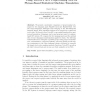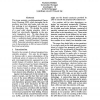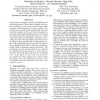COLING
2010
13 years 10 months ago
2010
Syntax based reordering has been shown to be an effective way of handling word order differences between source and target languages in Statistical Machine Translation (SMT) syste...
EMNLP
2010
14 years 1 months ago
2010
Automatic evaluation of Machine Translation (MT) quality is essential to developing highquality MT systems. Various evaluation metrics have been proposed, and BLEU is now used as ...
TSD
2010
Springer
14 years 2 months ago
2010
Springer
Abstract. We present a systematic comparison of preprocessing techniques for two language pairs: English-Czech and English-Hindi. The two target languages, although both belonging ...
MT
2010
14 years 2 months ago
2010
Translating between dissimilar languages requires an account of the use of divergent word orders when expressing the same semantic content. Reordering poses a serious problem for s...
CORR
1998
Springer
14 years 3 months ago
1998
Springer
This paper presents a multidimensional Dependency Grammar (DG), which decouples the dependency tree from word order, such that surface ordering is not determined by traversing the...
COLING
2002
14 years 3 months ago
2002
We present a quantitative model of word order and movement constraints that enables a simple and uniform treatment of a seemingly heterogeneous collection of linear order phenomena...
COLING
1992
14 years 4 months ago
1992
: This paper describes a possibility of expressing ordering constraints among non-sister constituents in binary branching syntactic structures on a local basis, supported by viewin...
EACL
1989
ACL Anthology
14 years 4 months ago
1989
ACL Anthology
In this paper we present a logical treatment of semifree word order and bounded discontinuous constituency. We extend standard feature value logics to treat word order in a single...
COLING
1996
14 years 5 months ago
1996
In this paper we present a GB-parsing system for German and in particular the system's strategy for argument interpretation, which copes with the difficulty that word order i...
COLING
2000
14 years 5 months ago
2000
In this paper we describe a method of acquiring word order fl'om corpora. Word order is defined as the order of modifiers, or the order of phrasal milts called 'bunsetsu...





